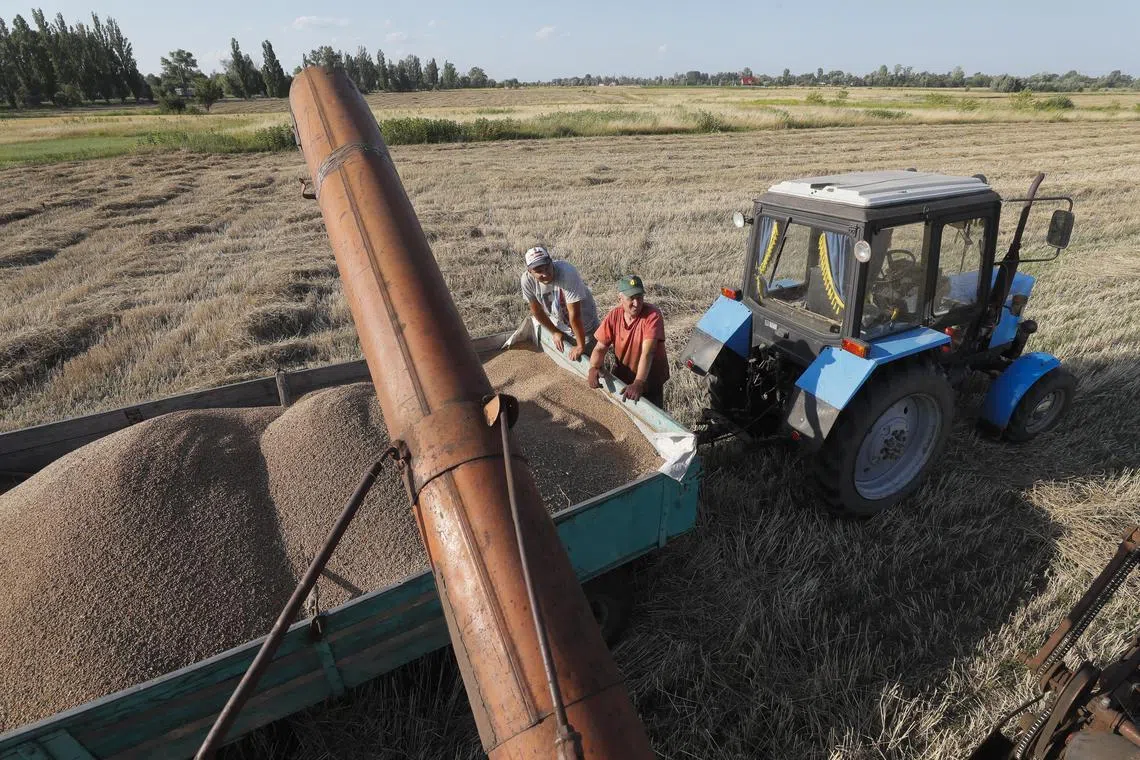What end of Ukraine grain export deal means for the world
Sign up now: Get ST's newsletters delivered to your inbox

Farmers drop grain from a combined harvester during a harvest near Kyiv, Ukraine.
PHOTO: EPA-EFE
Follow topic:
LONDON – Russia’s decision to quit the pact that allowed for safe passage of crops by sea out of the country it invaded, Ukraine, has again stoked worries about global food supplies and access. The accord had helped temper prices of wheat and vegetable oil that skyrocketed in 2022, when Russia’s attack cut off Ukrainian ports on the Black Sea from international commodity markets.
Ukrainian crops will still make it to market via other routes, but the higher transport costs could depress the next crop plantings due in just a few months – curtailing global supplies in the longer term.
1. Why is Ukraine so influential in global food markets?
Before the war, Ukraine exported more grain than the entire European Union and supplied about half of the globally traded sunflower seeds and oil. Even in the 2022-23 season – the first full year under Russia’s invasion – Ukraine has held its position as the sixth-largest wheat shipper and third for corn. As the season came to a close at the end of June, Ukraine’s grain exports were more than 48 million tonnes,
2. How did the grain deal work?
The grain deal signed in July 2022
Nearly 33 million tonnes were shipped in the year it was in force, led by corn, wheat and sunflower products. Monthly shipments via the corridor peaked at 4.2 million tonnes in October, but held below 3 million tonnes from April onwards as inspection times grew increasingly lengthy and Russia blocked ship registrations to one of the ports. Before the war, Ukraine exported as much as 5 million tonnes of grain a month in total via all routes.
3. Was the deal the only way out for Ukraine’s grain?
No. Problems with the pact pushed more crops towards Ukraine’s smaller Danube river ports, plus rail and road transit via the EU border. The tonnage shipped that way actually surpassed the volumes moved through the Black Sea corridor, at least as of May.
Still, those alternatives are more cumbersome and expensive than shipping via Ukraine’s deep-sea ports. Danube ports can only take smaller ships, which reduces volume, while grain exported by train is slowed by rails of different sizes at border crossings. Those shipments have also caused tensions with EU neighbours, who claim that the glut of grain coming in is hurting their farmers by depressing local prices.
The EU allowed five eastern member states to impose restrictions on purchases of Ukrainian grain domestically (transit shipments may continue). The ban expires in September, but the five have called for an extension.
4. Why did Russia pull out of the deal?
Russia said it was because obstacles to exporting Russian fertilisers and food were not lifted. That is despite the fact that Russia is shipping record volumes of wheat, and its fertiliser exports are recovering to pre-war levels. Food is not directly targeted by sanctions, but penalties on Russian banks and international companies like John Deere deciding to pull out of the Russian market caused problems for farmers because they could not get some replacement parts or seeds.
Russia’s foreign ministry made five main demands to stay in the deal, including for agricultural bank Rosselkhozbank to be reconnected to the Swift international payments system, resolving issues with securing spare agricultural machinery parts and reopening an ammonia pipeline. Russia said those demands had not been met, and that it saw no progress solving other issues with transport logistics and insurance and unfreezing of assets.
5. Which buyer nations may suffer most from this?
China, Spain and Turkey have been the biggest buyers of Ukrainian foodstuffs shipped through the safe corridor, but poorer countries like Egypt and Bangladesh also imported over a million tonnes each under the programme. The UN has emphasised that shipments under the deal help boost global supplies and bring down prices, regardless of where the grain is shipped to. Global grain prices initially spiked after Russia’s exit from the deal.
6. What does it mean for Ukraine’s farmers?
Ukraine is pushing for grain exports to continue from the Black Sea ports, despite Russian warnings. The US said shipping escorts are not an option, and insurance broker Marsh suspended its programme for grain exports from Ukraine, underscoring the challenges. In the long run, if Ukraine can export only through alternative routes, that will increase costs for farmers.
That could induce them to cut plantings further, resulting in lower supplies from Ukraine further out. The war has already cut the area that farmers are planting. BLOOMBERG

